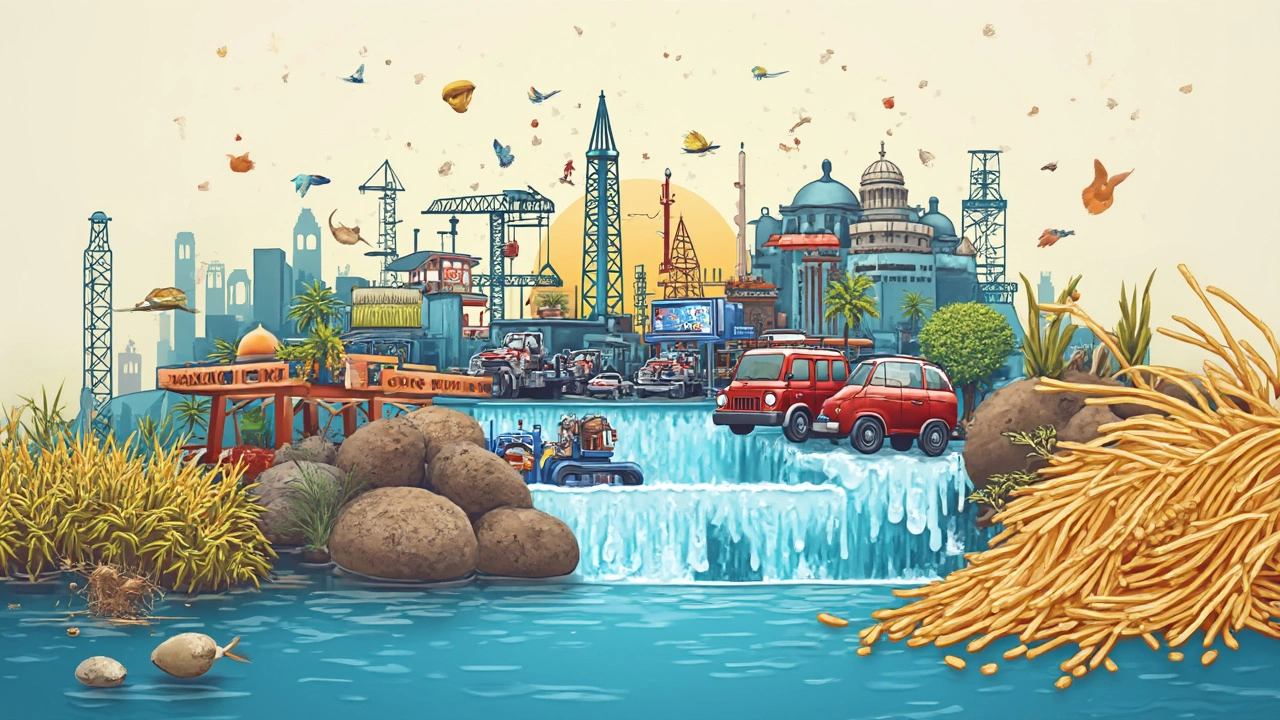
Ever wondered how India is doing in the global trade market? It's a mixed bag, really. India, with its vast resources and diverse economy, plays a significant role in international trade. But just because it's big doesn't mean it's easy. There's a lot to unpack when it comes to understanding the interplay of factors that determine if trade is, well, 'good.'
For starters, let's talk about the numbers. India's trade performance has been a rollercoaster. The country is one of the largest exporters of software and textiles. Yet, it imports a vast majority of its oil. That's a pretty complex balance. You might ask, is that a good trade situation? Depends on who you ask. But it certainly keeps the economy dynamic and opportunities abound for traders willing to dive into specific sectors.
So, why should you care? For those looking at trade courses in India, getting a grip on this dynamic landscape is vital. Whether you're eyeing a career in international business or just curious how those spices end up in your kitchen, understanding India's trade setup is both insightful and practical. And knowing the trade-offs—pun intended—can provide a huge edge.
- India's Trade Performance
- Major Exports and Imports
- Trading Challenges
- Trade Policies and Economy
- Trade Courses and Opportunities
India's Trade Performance
There's a lot happening with India's trade performance. Over the years, India has emerged as a major player in the global market, but not without its ups and downs. One of the key things to note is the growth in its GDP due in part to trade. It's got this huge market and a workforce ready to get things moving. But let's get specific.
First off, India is known for being one of the largest exporters of software and IT services. You've probably heard of companies like TCS and Infosys making waves globally. That sector alone makes up a decent chunk of India's GDP. It's like the world relies on India's coding skills!
Exports vs. Imports
India exports a lot of textiles and agricultural products too. Imagine all those shirts that say 'Made in India.' But it's not all smooth sailing. India imports a significant amount of its crude oil. This imbalance can sometimes lead to trade deficits, especially when oil prices soar.
Check out this simple look at India's major exports and imports:
| Category | Exports (Billion USD) | Imports (Billion USD) |
|---|---|---|
| Software & IT | Approx. 150 | 2 |
| Textiles | Approx. 40 | 1 |
| Agriculture | Approx. 35 | 5 |
| Crude Oil | 5 | Approx. 140 |
Impact of Trade Policies
Throughout the years, Indian trade policies have shaped this landscape. Policies are revised regularly, making it important for businesses to stay up-to-date. Trade agreements with other countries can open up opportunities or close existing ones. Anyone looking into trade courses should study these changes closely.
To cap it, while India has some hurdles, the overall trade scene keeps buzzing due to a huge domestic market and a strategic approach to sector-specific exports. Trade performance is like a dance; sometimes it steps forward, sometimes back. But it's always in motion.
Major Exports and Imports
India's trade ecosystem is like a bustling market, full of colorful things going in and out. Let's break it down by what India sends abroad and what it brings in. Understanding this can help spot opportunities, especially if you're thinking about taking up trade courses in India or just exploring the Indian economy.
Top Exports
India is famous for its software and IT services—no surprises there. It's a powerhouse in this sector, exporting a massive amount of tech services to the world. You can also count textiles, gems, and jewelry among India's most shining exports (literally, in the case of diamonds). Agricultural products like rice and spices play a huge role too. Ever wondered where that curry spice comes from? Now you know.
Take a look at this snapshot:
| Product | Export Value (in billions USD) |
|---|---|
| Software/IT Services | 148 |
| Textiles | 40 |
| Gems & Jewelry | 30 |
| Agriculture | 45 |
Major Imports
Then there's what India imports. Oil is at the top—this keeps the country running, literally. Electronics like mobile phones are another biggie. And then there's gold. Not just for bling, gold is a significant financial asset in India.
- Oil: Covers energy needs and fuels growth.
- Electronics: Power the tech boom.
- Gold: Both a luxury and a savings plan for many households.
In balance, India's trade seems to juggle high-tech exports with essential imports. It's a delicate dance that defines the trade opportunities here. Dive deeper, and who knows? You might just find your spot in this dynamic and ever-evolving market.

Trading Challenges
When you're in the world of India trade, hurdles and obstacles are part of the game. Some challenges are pretty straightforward—like logistics and infrastructure—but others can be a bit surprising.
Logistical Snags
India's infrastructure is improving, but there are still bottlenecks, especially in ports and roadways. Congestion can lead to delays and this can be a nightmare for anyone dealing with perishable goods. For instance, the turnaround time at some Indian ports is longer compared to other global ports, adding costs.
Tariff and Non-Tariff Barriers
Import duties and regulatory measures can also pose challenges. While smaller tariffs exist, the complexity of navigating these duties can be daunting. Plus, the government frequently updates these policies, so staying updated is crucial.
Quality Standards and Certifications
When it comes to exports, sticking to international quality standards is critical. Different countries have their own certification requirements. Indian traders often need to acquire multiple certifications, which can be time-consuming and costly.
Foreign Exchange Fluctuations
Currency fluctuation is another challenge. A change in the rupee's value can significantly affect profitability. While some companies use currency hedging to mitigate risks, it's not without cost.
And let's not forget trade wars and geopolitical tensions that can shift trade policies overnight. Navigating these changes requires agility and expertise—it's not just about getting a course; it's about taking the leap into a complex, but rewarding landscape.
Trade Policies and Economy
India's trade policies are a big piece of the puzzle when you're trying to grasp how the country's Indian economy ticks. Over the years, these policies have evolved to promote exports, regulate imports, and attract investments. But how exactly do these policies affect the everyday trader or businessman? Well, let's break it down.
Key Trade Policies
India has set out specific guidelines to channel both local and foreign trade activity. The Foreign Trade Policy, for example, is reviewed every five years and aims to boost India's trade potential by simplifying export license processes and providing incentives like the SEIS (Service Exports from India Scheme). Such programs provide tax exemptions and other benefits that make it easier and more appealing for businesses to engage in international commerce.
Additionally, there's the Make in India initiative. Launched in 2014, this policy focuses on transforming India into a global manufacturing hub by promoting self-reliance. The government offers incentives across various sectors like textiles, electronics, and defense manufacturing, encouraging both domestic and foreign firms to set up shop within the country.
Impact on the Economy
These policies do more than just generate paperwork—they drive substantial economic activities. The impact on GDP is significant, with trade contributing about 40% of India's GDP. That's massive for a country with over a billion people. The more streamlined these policies are, the smoother the India trade engine runs.
There's also a social angle. Policies aimed at empowering micro, small, and medium enterprises (MSMEs) help grassroots entrepreneurs to participate in trade, impacting local economies positively. And if trade courses in India have taught us anything, it's that understanding these policies can give businesses an edge by allowing them to navigate the Indian market landscape more effectively.
Challenges in Implementation
All is not rosy, though. While policies are set with the best intentions, implementation can be tricky. Factors like bureaucratic red-tape and fluctuating global relations often pose challenges. For example, geopolitical tensions can lead to sudden changes in import duties, impacting sectors heavily reliant on foreign materials.
In essence, becoming savvy with trade policies is not optional if you're looking at participating in the rich and sometimes complicated tapestry that is Indian trade. Knowing the rules not only helps avoid pitfalls but also uncovers avenues you might not have considered.

Trade Courses and Opportunities
Diving into the realm of trade courses in India is like unlocking a treasure chest filled with potential. These courses are designed to equip you with the skills you need to navigate this vibrant and sometimes chaotic market. But what do these courses actually offer?
India trade courses often include modules on international business laws, negotiation strategies, market analysis, and cultural competence. This doesn't just arm students with the necessary knowledge but also the confidence to step into a room full of global traders and hold their own.
Popular Courses to Consider
If you’re serious about breaking into the Indian economy or aiming to enhance your career in this direction, look no further than institutions like the Indian Institute of Foreign Trade (IIFT) and the Export-Import Bank of India (EXIM). They offer specialized programs that cover everything from export documentation to supply chain logistics. Both hands-on and theoretical learning is emphasized, making sure you get a balanced education.
- Export-Import Management - Learn the nitty-gritty of managing exports and imports, extremely relevant for sectors like textiles and machinery.
- International Trade Law - A deep dive into the legalities of global trading, which can save you heaps of money and potentially keep you out of hot water.
- Global Market Strategies - Hone in on how to effectively enter and establish oneself in international markets.
Opportunities Abound
After completing a trade course, a wide array of job opportunities open up. Companies that focus on export opportunities, import agencies, and international logistics businesses are on the lookout for individuals who can bring a fresh perspective. Seasoned entrepreneurs and even start-up owners find these courses immensely valuable as they offer insights that textbooks don’t always cover.
Consider this: Many graduates find roles as trade analysts, logistics managers, and even product development specialists focused on tailoring products for overseas markets. The opportunities expand even further once you have a global perspective.
If you're still wondering whether it’s worth it, take a look around. With India projected to grow its export market significantly in the coming years, the skills learned in these courses could very well be your golden ticket into a thriving industry that's constantly on the move.
